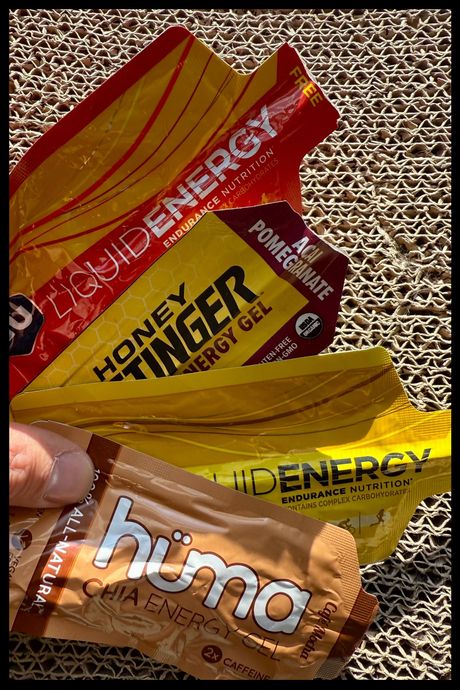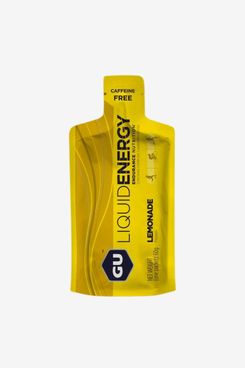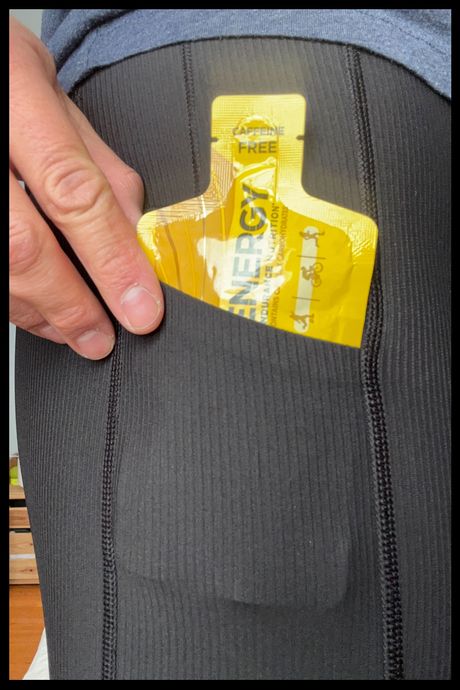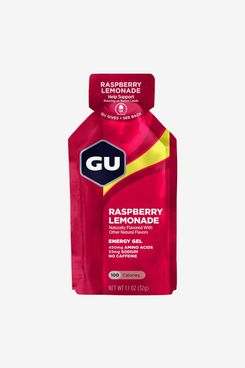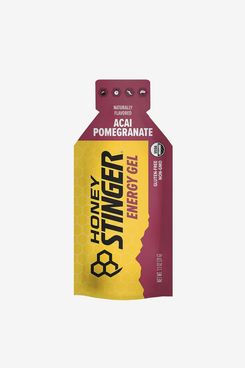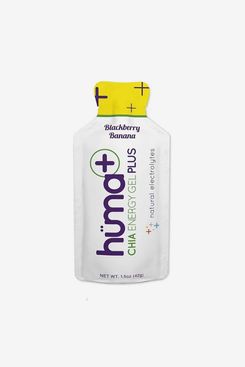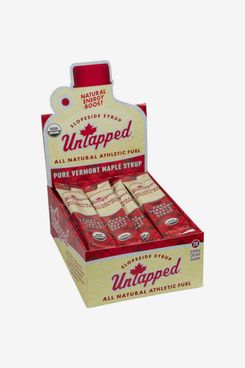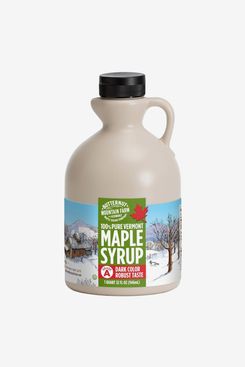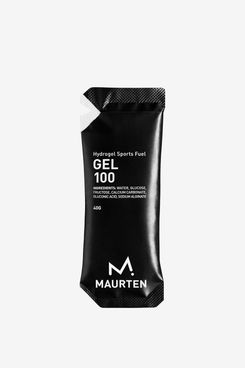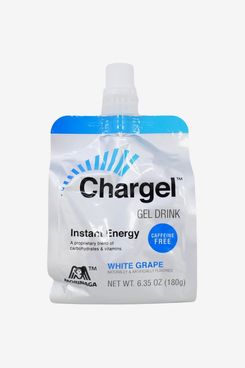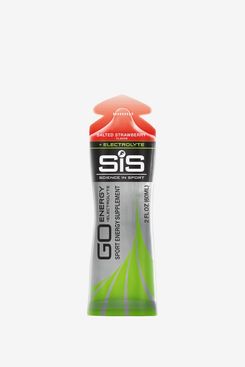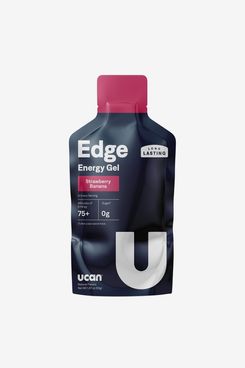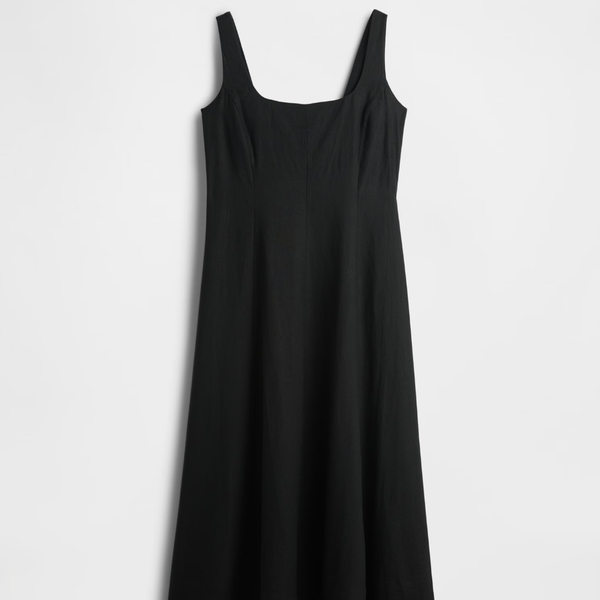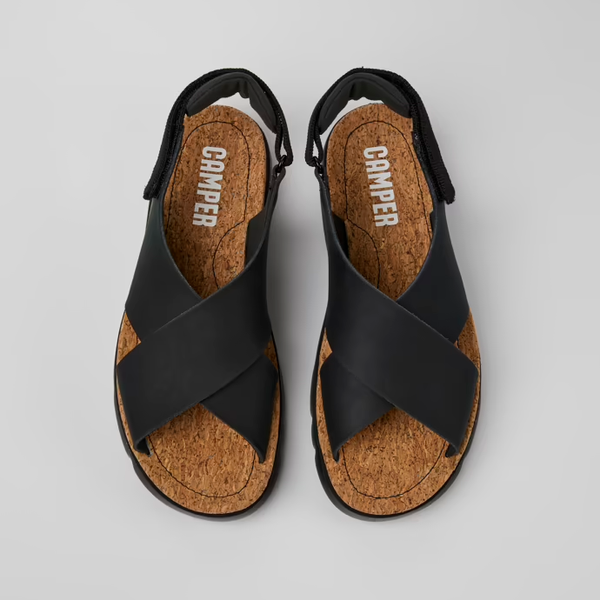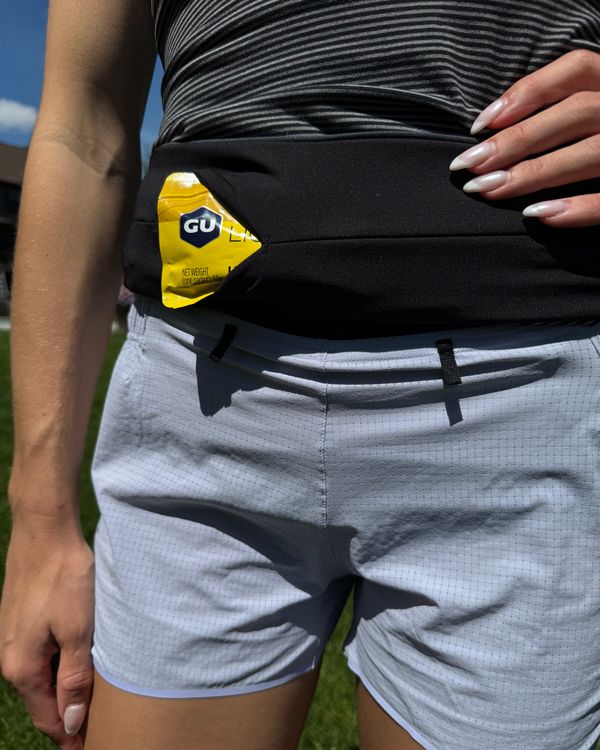
In this article
“I hit the wall at mile 19 of the Big Sur Marathon in spring of 2024,” recalled Strategist associate editor Jeremy Rellosa. “My muscles seized up, I had full-body cramps, and I hobbled across the finish line as my splits ballooned.” Sometimes these things happen and are out of our control, but in this case, Rellosa knew he had neglected to eat enough calories. Energy gels are an efficient way to avoid his fate because they deliver high amounts of carbohydrates (and other nutrients) in a readily digestible form that your body can tolerate while working at or near its physical limits during an endurance race or training session.
Real food or candy is one option, but registered dietitian and professional runner Maddie Alm explained that chewing food and digesting fiber and protein will only add further strain to your already hardworking body. “What your body needs is quick sugar,” said Alm. “Gels take away the need for you to break down other types of nutrients and just give you that hit of carbohydrates.”
The right gel for you comes down to two main factors: how it tastes — including its texture — and whether your stomach will tolerate it mid-workout. Because they’re primarily made of sugar, most gels taste like candy — although some use more natural-tasting flavorings than others. The texture ranges from that of cough syrup to something akin to applesauce or brownie batter.
Whatever you choose, make sure to stick with it. Strategist newsletter editor Ashley Wolfgang tried mixing it up by using a sample packet from a sponsor of the marathon she was training for, only to find herself bloated and in pain during one of her final training runs. “I can’t imagine how devastating that would have been if that happened on race day,” she said. “So word of advice: Always test your fueling strategy as a part of your training plan, and never try anything new on race day.”
To find the best energy gels, my colleagues and I spoke with seven runners, endurance athletes, registered dietitians, and coaches to hear about their favorites. We also added our own testing notes for each recommendation.
Updated on July 3, 2025
We made sure all of our picks are in stock and priced correctly.
What we’re looking for
Consistency
Thin: These gels will feel liquidlike and are easy to consume or drink. Sometimes, you might not need liquid to take these.
Thick: A traditional gel will have a thicker, syrupy consistency that is best taken with water.
Real food: Some gels are made with real fruits and vegetables, and they generally have a purée-like texture and consistency.
Hydrogel: These gels have a watery, Jell-O-like consistency that is less sticky than a traditional gel.
Carbohydrates
Carbohydrates are the most basic ingredient in an energy gel. Most gels will have anywhere from 20 to 40 grams of carbohydrates per packet.
Cost per serving
The gels I looked at range between $1.67 to $3.75 per serving. The pricier options tend to accommodate specific dietary needs and restrictions, whereas the cheaper ones are more simply formulated. While you might not feel a $2 difference per packet in a week or two, it adds up to hundreds of dollars over the course of a multi-month training schedule.
Electrolytes
When we exercise, we lose electrolytes through sweat (mostly sodium, but also potassium, calcium, and magnesium), and it’s crucial to try and replenish them. Most energy gels don’t typically have a lot of electrolytes in them, but there are some versions of gels that have more sodium. Alm recommends getting 300 milligrams of sodium from electrolytes or gel per hour, which, she admits, can be hard to do mid-run. “The goal is to try to minimize losses to the point where they’re not impacting performance, and then make sure we’re really replenishing those post-run,” she says.
Caffeine content
Most gels will be available in either a caffeinated or non-caffeinated option. Some folks prefer caffeine to help with performance — some runners like having caffeinated gels in the later sections of a marathon for an extra boost — but it’s not for everyone, especially if you are sensitive to caffeine or have GI issues. If you’re interested in trying caffeinated gels, the experts I spoke to said to make sure to practice with them ahead of race day.
Flavor options
Gels come in all sorts of flavors, from unflavored versions, to the fruit-mix variety, to sweet-tasting options such as chocolate and vanilla, to salty flavors. I’ve listed all the options available for each gel.
Best energy gel overall
New! You can now save this product for later.
Consistency: Thin | Carbohydrates: 23g | $/serving: $2.50 | Electrolytes: 190mg of sodium | Caffeine content: 0mg, available in caffeinated versions | Flavor options: Lemonade, coffee (caffeinated), orange (caffeinated)
Gu’s energy gels might be the most recognizable and well known in the endurance-sports world. They’ve long been the standard, offering a variety of flavors and caffeine options, all in a compact package. While the regular concentrate gel is better known, Alm recommends the Liquid Energy because of its thin consistency, which doesn’t require immediate chasing with gulps of water. They also contain 190 mg of additional sodium (compared to 55 mg in the regular kind), which helps prevent dehydration. During my testing, I tried the gels out on a few of my harder runs and found that the pouch tore open easily and was flat enough to go unnoticed in my running belt. The liquid went down smoothly, and since it’s on the watery side, it gave me the feeling that I was quenching some of my thirst. When senior writer Michael Zhao tried several flavors, ranging from more natural-tasting ones (lemonade, coffee) to pure candy (strawberry banana, cola), he found that all of them were reasonably palatable, too.
“They’re now my preferred gel because of their high sodium content and how easy they are to consume,” said Rellosa after trying Gu Liquid for his last two marathons. “I don’t have to chew to get it down — I just slurp and knock it back, almost like a shot.”
New! You can now save this product for later.
Consistency: Thick | Carbohydrates: 23g | $/serving: $2.00 | Electrolytes: 55mg of sodium | Caffeine content: 0 mg, caffeinated options available | Flavor options: Vanilla, campfire s’mores, caramel macchiato, salted caramel, espresso, salted watermelon, strawberry banana, chocolate, mandarin orange, cola, lemon, birthday cake, triberry, jet blackberry
Gu’s standard gels pack the same amount of carbs into a much smaller and more portable packet that’s easier to carry and is slightly more affordable as well. The trade-off is that the consistency is quite thick, so these must be ingested with plenty of water.
This goopier consistency takes well to dessert-like flavors such as chocolate (think brownie batter) and s’mores. But it also works with fruitier ones. Rellosa is partial to the raspberry lemonade: “It has an acidity and sweetness to it that I crave some days.”
Best (less-expensive) organic gel
New! You can now save this product for later.
Consistency: Thicker | Carbohydrates: 24g | $/serving: $1.67 | Electrolytes: 50mg | Caffeine content: 0 mg, caffeinated options available | Flavor options: Fruit smoothie, strawberry kiwi, honey
Like Gu, Honey Stinger is a well-known brand in the endurance-fuel world, and you’ll likely spot its gels at any running shop or race. The simple formulation of organic tapioca syrup and honey (plus electrolytes and flavorings) has a consistency similar to that of honey on its own and is easy for most people to digest. “It’s pleasant to consume, coating the mouth in bold fruit flavor and honeyed sweetness — just shy of cloying — before washing down easily with a sip of water,” Zhao says. “It tastes like the high-quality, fruity hard candy you might grab from the checkout line at a health-food store.” And at $1.67 per serving, it’s one of the most affordable prepackaged options available from any brand.
It’s a favorite of marathoner and Strategist newsletter editor Ashley Wolfgang. “I’ve been training and racing with Honey Stinger Acai Pomegranate gels for about five years now and can’t imagine using anything else. I love the taste, and the gel sits well with my stomach while providing the energy and electrolytes I need to keep going,” she says. “The acai and pomegranate flavor taste a little like a melted smoothie, and the consistency is smooth (like the name states) like honey and doesn’t taste synthetic.”
Best gel with extra electrolytes (made of real food)
New! You can now save this product for later.
Consistency: Real food | Carbohydrates: 21g | $/serving: $2.75 | Electrolytes: 240mg | Caffeine content: 0 mg, caffeinated option available | Flavor options: Blackberry banana, lemon lime, strawberry lemonade, berries and pomegranate
Huma’s formulations contain mostly fruit purées and juices from concentrate, with a touch of chia-seed powder for thickening. Hence, they have less of the cloying sweetness associated with syrup-based options. While all of the flavors Zhao tried tasted pretty good, he says the double-electrolytes formulation is notable because it contains 240 milligrams of hydration-sustaining sodium per packet. The lemon-lime version reminded him of the salted lemonade you can get at some Vietnamese restaurants.
“I often preach to my runner friends about how we don’t get enough electrolytes in our gels,” said Rellosa. “This is the gel I prefer for hot days (especially during summer-marathon training blocks), when I’m losing a lot of electrolytes through sweat.” He likes the blackberry-banana flavor because it’s not part of the usual lemon-lime or strawberry flavor roster you’ll find with most gels.
Best gel with simple ingredients
New! You can now save this product for later.
Consistency: Thin | Carbohydrates: 26g | $/serving: $2 | Electrolytes: 5mg of sodium, 82mg of potassium, 39mg of calcium | Caffeine content: 0 mg, caffeinated option available | Flavor options: Maple syrup, coffee, salted raspberry, salted citrus, salted cocoa
The only ingredient in UnTapped is pure organic maple syrup in a convenient little package. Despite the small packets, it’s actually quite easy to swallow, even without taking a drink of water. Perhaps needless to say, it tastes like maple syrup. UnTapped also makes salted flavor options, which have 60 milligrams of sodium per serving (the salted citrus flavor has 100 milligrams of sodium per serving).
New! You can now save this product for later.
Consistency: Thin | Carbohydrates: 27g | $/serving: $0.54 | Electrolytes: 5mg of sodium, 90mg of potassium, 30mg of calcium | Caffeine content: 0 mg | Flavor options: Maple syrup
While $2 per serving is a good price for gels, you can get pure maple syrup for about $0.54 an ounce if you’re willing to package it yourself in something like a HydraPak gel flask. One of these 150 mL flasks holds five gel packets’ worth of syrup and can be washed and reused for years.
Competitive endurance cyclist (and product designer) Jono Freeman landed on self-packaged syrup after trying almost every option out there — including several of our picks. “It all tasted great and made me feel like a superhero, but as an unsponsored athlete racing for fun, the marginal performance benefits didn’t justify the cost,” said Freeman of the manufactured gels. “I was impressed by how good I felt after switching to syrup, and the knowledge that I’m supporting local farms doesn’t hurt either.” As for electrolytes, “For my first 200-mile ride, I brought along one of those tiny plastic bags full of pink rock salt and would pop a couple into my mouth every hour or so.”
Best gel for sensitive stomachs
New! You can now save this product for later.
Consistency: Hydrogel | Carbohydrates: 25g | $/serving: $3.75 | Electrolytes: 20mg of sodium, 6mg of calcium | Caffeine content: 0 mg, available in caffeinated version | Flavor options: Flavorless (sweet)
Maurten is known for its proprietary hydrogel mixture, which the brand claims can help reduce GI issues and is easier to consume than traditional gels. Maurten also made big news in the endurance world when Eliud Kipchoge used the company’s gels during his historic sub-two-hour marathon in 2019. Since then, it’s become the most popular energy gel in the endurance world (if you race, you’ve likely spotted torn black-and-white Maurten packs on the course).
The Gel 100 has an unflavored but sweet taste (the caffeinated version is slightly bitter), and in Rellosa’s experience, it goes down pretty easily, even without water or a sports drink. Hector Santana, the founder of the running group NYC Dragons, credits Maurten gels with helping him shave 90 seconds off his half-marathon mile splits. However, at $3.75 per serving, it costs more than twice as much as some of our more affordable recommendations.
Best gel for long-distance races
New! You can now save this product for later.
Consistency: Hydrogel | Carbohydrates: 45g | $/serving: $3.50 | Electrolytes: 60mg of sodium | Caffeine content: 0 mg | Flavor options: White grape, strawberry, apple
Chargel is the first gel we’d recommend if you’re looking for a gel with a higher carbohydrate intake — especially if you’re running or training for long-distance races, such as an ultramarathon — since it has nearly twice the amount of carbs compared to others on this list (for example, 45 grams of carbohydrates compared to our best overall Gu’s 23 grams). It comes in a pouch with a twist-off top (a handy feature that allows you to consume some of the gel immediately and some later) and has the Jell-O-like consistency of a Maurten gel combined with the watery viscosity of a Gu Liquid Energy. During my testing, I found these pouches to be a bit bulky, so they might not be as ideal for someone who doesn’t wear a running belt or prefers to simply tuck gels into their shorts waistband. That said, their large size makes them suitable for extra-intense performances, such as running significantly farther than a traditional marathon or enduring a multiday cycling event. And the fact that they’re resealable means you can hang onto the pouches for longer without spilling sugary goop everywhere.
San Francisco–based ultrarunner Paul Atienza uses them as his main source of fuel on long runs for marathon training. “They remind me a lot of the jelly candy cups that you’d get at Asian grocery stores,” he says. “I feel like you can drink and even savor them easily throughout the run as opposed to feeling the need to consume like other training fuel. A great combo I’ve found late in an ultra with them is to take it with chips.”
Easiest gel to consume
New! You can now save this product for later.
Consistency: Thin | Carbohydrates: 22g | $/serving: $1.83 | Electrolytes: 100mg of sodium | Caffeine content: 0 mg | Flavor options: Raspberry, salted strawberry
If your priority in an energy gel is quick consumption without additional water, we recommend this one from Science in Sport, which has the thinnest consistency of all the gels on this list. It’s so diluted that it basically drinks like a beverage. Zhao’s favorite flavor is the salted strawberry, which reminds him of a salty electrolyte powder. Heads-up: Its packaging is a bit bigger than a regular gel, so if you have shallow pockets, these might be hard to stuff in (or they might slip out).
Best gel for blood-sugar management
New! You can now save this product for later.
Consistency: Thin | Carbohydrates: 20g | $/serving: $3.33 | Electrolytes: 50mg of sodium | Caffeine content: 0 mg | Flavor options: Unflavored, strawberry banana, orange mango, pineapple
What makes UCan’s Edge gel different from other gels is that it’s made from hydrolyzed cornstarch, which means it releases carbohydrates at a slower rate than what you’d get with other gels. That’s why registered dietitian and runner Kristy Baumann recommends it for people who don’t want their blood sugar to spike quickly after consuming a gel. “I often recommend these gels for somebody who is pre-diabetic, diabetic, or concerned about their blood-sugar management,” she says. “You’re not necessarily going to feel that boost of energy from taking a UCan gel. Rather, it’s steady energy throughout.”
Additional reporting by Jeremy Rellosa
The Strategist is designed to surface useful, expert recommendations for things to buy across the vast e-commerce landscape. Every product is independently selected by our team of editors, whom you can read about here. We update links when possible, but note that deals can expire and all prices are subject to change.
